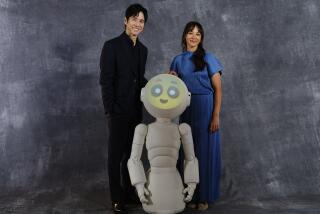Human Resources
- Share via
Researchers still have a ways to go before they reach their goal of creating a computer-generated person that looks realistic. But they are already trying to make them think like people.
Blending artificial intelligence with computer graphics was a main topic of discussion at last week’s Virtual Humans 3 conference in Universal City. Engineers hope to use virtual humans in applications ranging from military combat simulations to video games to educational exercises.
“When [‘Tomb Raider’ heroine] Lara Croft keeps running into a brick wall over and over and over and doesn’t seem to mind, it makes you think that maybe she doesn’t know what’s going on,” said Bruce Blumberg, an assistant professor at the MIT Media Laboratory (which actually makes virtual animals).
Topping researchers’ wish list are avatars that can automatically adapt their behavior to changing circumstances and learn based on past experience, said Michael Zyda, a member of the computer science faculty at the Naval Postgraduate School in Monterey. On the flip side, Jeff Rickel and his colleagues at the Information Sciences Institute are creating a virtual human to teach real humans how to perform tasks.
Some companies still abide by the maxim that the most important thing is to look good, and one of them--Santa Clara-based Haptek--is focusing on making realistic faces.
Instead of trying to pre-program every possible facial expression in minute detail, Haptek engineers start with about a half-dozen basic elements of facial expression, like a face’s degree of symmetry or emotional intensity. Then Haptek’s People Putty software combines those elements with other factors--like the way your face looks when you’re in a bad mood or how you react when a butterfly floats by--in an infinite number using the mathematical principles of chaos theory, explained Chris Shaw, Haptek’s co-founder and chief executive. Shaw plans to license the virtual heads to companies that make virtual bodies.
Sound far-fetched? That’s OK with Marty Stoneman, founder of Anthrorobotics, a start-up firm in Phoenix.
“If you don’t sound ridiculous, you’re not talking about the future,” he said.







